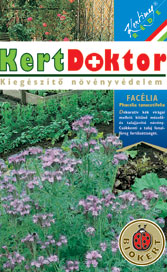Musk Grass (Facelia) Garden Doctor 30g
| HUF 3,425 * (nettó: HUF 2,697) | |
Beacons of Honeysuckle:
Seed need:
14-16 kg/ha.
Honeysuckle (facelia, bee balm, caterpillar flower) is a relatively new crop in Europe. Mostly important as a bee-feeder, it is also widely used as fodder, ornamental and green manure. The excellent honeymaking value of the facelia is due to its extremely rapid development and its long continuous flowering (4-8 weeks). Its flowers are very attractive to the honey bee. The nectar has a high sugar content (28 %) and produces about 1,8 mg per flower. Four to six hives can be planted on 1 hectare of facelia and the honey yield per hectare can exceed 800 kg. The honey is pale brown, slightly opalescent. Mown when young, the plant is very good fodder. The mineral content of freshly mown honeysuckle is shown in Table 1. When grown for fodder, it is a spring and second crop, but when grown for seed it can only be sown in spring.
Advantages of growing honeysuckle:
Facelia is a very healthy plant. It is a very healthy and healthy plant. Its fast growth, good vitality, long flowering period, frost resistance and its ability to grow independently of the time of day make it one of the most popular catch crops and green manure plants. Its fine, rapidly decomposing rootstock is rich in nitrogen, phosphorus, potassium and calcium. Its root system creates a soil condition that significantly improves the energy use of ploughing. It is also a valuable crop for crop rotation due to its nematostatic and nematicidal action. The cultivation of facelia as a cover crop has two environmental advantages. The first is the prevention of nitrate leaching: the crop absorbs the nutrients released from the soil to enable it to grow rapidly. The other is related to providing cover: mulch prevents weeds from germinating, thus reducing the amount of herbicide needed, for example for catch crops (sunflower, maize, sugar beet).
Requirements of Honeysuckle:
Soil requirements:
Despite the fact that muskmelon does not require excessive nutrients to grow and is beautifully ornamental in average quality soils, facelia is a plant of medium-textured soils with good capillary water-holding capacity. Under domestic conditions, it can be grown successfully in all arable fields, except in frost-prone and northern exposed areas, provided that rapid and uniform emergence can be ensured. It is avoided on bound 'cold' soils and on shallow soils with a humus content of less than 1,2 %. In drought areas, summer drought can cause significant damage to the stand.
Temperature requirements:
Germination lasts 5-14 days, further stimulated by pre-cooling. Minimum germination temperature is 5 °C, optimum 16-20 °C and maximum 30 °C.
Water requirements:
Not high during the growing season, but abundant yields can be expected in moderately warm, rainy weather until flowering.
Honeysuckle cultivation techniques:
Sowing:
Sowing time, the determinant of use. For seed production, facelia should be sown in late March/early April. For beekeeping, sowing can also start in April and can last up to mid-June with 1-2 week intervals. Sowing too early can lead to thinning or even extinction of the crop. As a green manure it can be sown at any time of the year, even after the field has been fallowed. For mulch, even August sowings can be successful.
Sowing depth should be 2 to 4 cm depending on the physical composition of the soil. Deeper sowing is recommended on loose, sandy soils. It is very important that the seeds are sown to the same depth so that germination is uniform.
Spacing:
Spacing for forage 12 cm
Spacing for beekeeping 24-36 cm
Flowering time from sowing:
Flowering times according to sowing time:
March sowing: flowering at 11 weeks
April sowing: flowering in 7-8 weeks
May-August sowing: flowering in 6 weeks
Autumn sowing: flowering in May
| Weight: | 0.03 kg |
|---|---|
| Aviability: | 1-4 nap |
| Basic sales unit: | db |
| Culture: | Bio |
Login
Login
